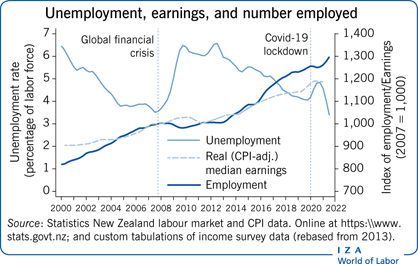Elevator pitch
New Zealand is a small open economy, with large international labor flows and skilled immigrants. After the global financial crisis (GFC) employment took four years to recover, while unemployment took more than a decade to return to pre-crisis levels. Māori, Pasifika, and young workers were worst affected. The Covid-19 pandemic saw employment decline and unemployment rise but this was reversed within a few quarters. However, the long-term impact of the pandemic remains uncertain.

Key findings
Pros
Employment rates are above 2000 levels, despite strong population growth; and high employment rates, rising for older workers, are accompanied by low unemployment.
There is moderately strong real wage growth, even with slow growth during the GFC recovery, and relative wage growth for women and the low-paid, reducing the gender wage gap and compressing the wage distribution.
There has been strong growth in qualifications.
Lower job turnover rates indicate greater job stability.
New Zealand is recovering since the 2020 Covid-19 pandemic.
Cons
Long-term unemployment (i.e. six months or more) remains high at around 30% of total unemployment.
Young workers as well as Māori and Pasifika ethnic groups still face relatively high unemployment rates.
Wage inequality has risen somewhat in the upper half of the wage distribution since 2000.
Qualification premiums have declined.